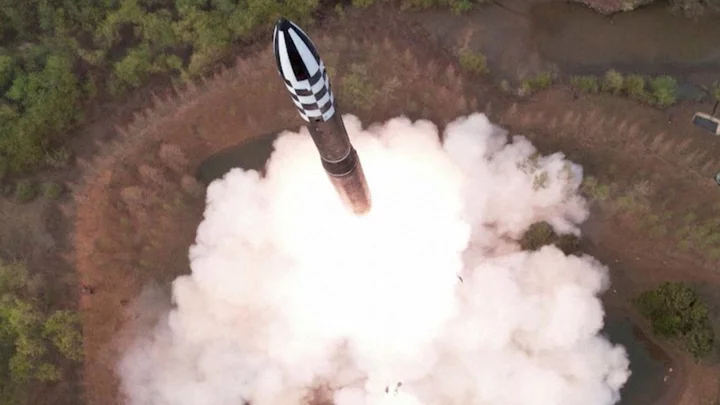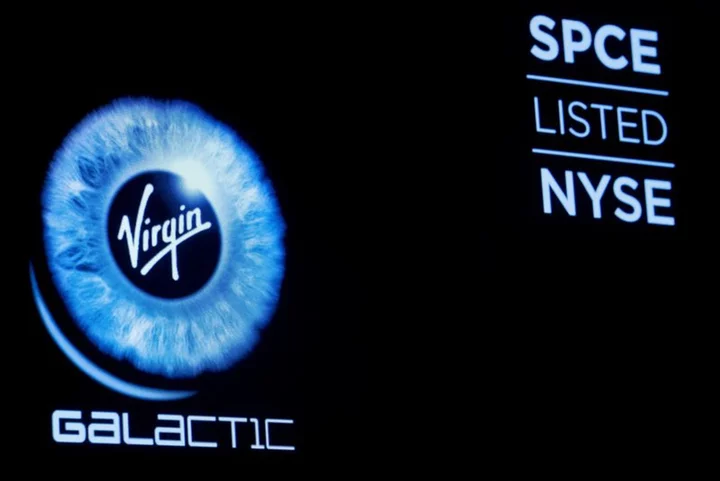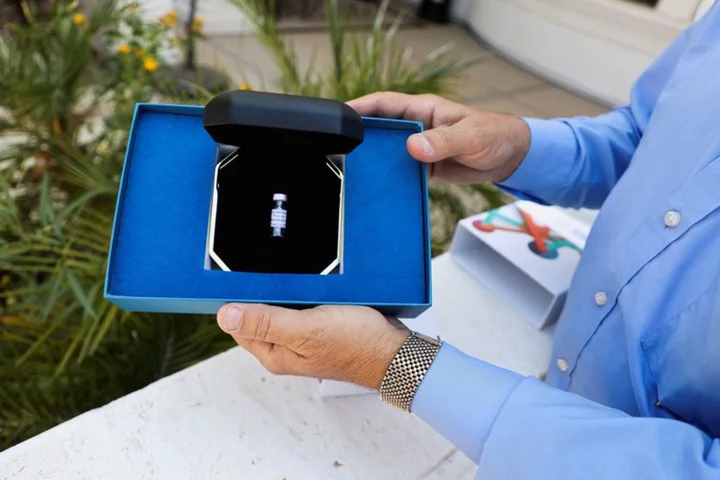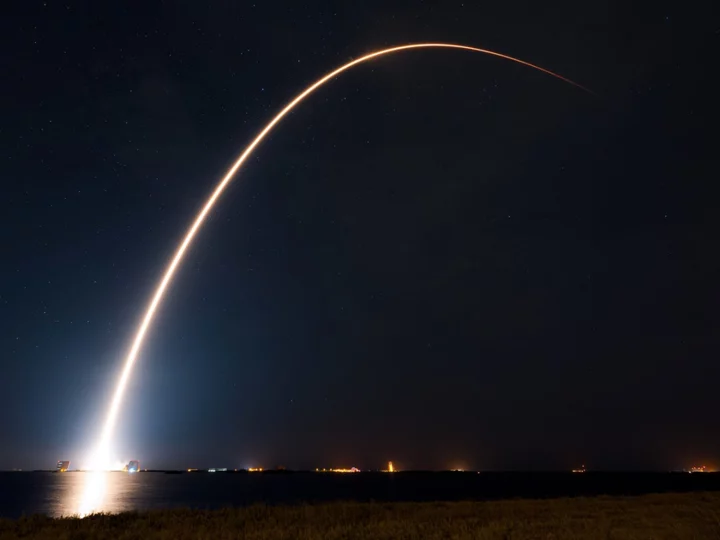
Kevin Spacey 'misread the signs' but did not assault man, actor tells London court
By Sam Tobin LONDON Oscar-winning actor Kevin Spacey said on Friday he "definitely misread the signs" when he
1970-01-01 08:00

Investors in VinFast's SPAC for US listing cash out most shares
HANOI Shareholders of Black Spade Acquisition, a special purpose acquisition company (SPAC) that has plans to merge with
1970-01-01 08:00

‘Ghost stars’ have aligned themselves in a strange pattern in our galaxy – and scientists might now know why
“Ghost” stars are aligned in beautiful structures near the centre of our galaxy, scientists say – and they might finally be getting to know why. Researchers discovered the unusual alignment of these planetary nebulae ten years ago, when Manchester doctoral student Bryan Rees spotted them. But it has remained a mystery how they came to be that way. Now scientists have been able to confirm that unusual alignment. But they have also made a breakthrough in finding out why they are there, after they found that a particular group of stars known as binary stars is responsible. Planetary nebulae are gas clouds that are thrown out from stars when they come to the end of their life. Our own star, the Sun, will do the same in about five billion years. Those ejected clouds are like ghosts of their dying stars, and assemble themselves in beautiful shapes, researchers say, such as an hourglass or butterfly. Researchers studied a range of planetary nebulae that are near the centre of our Milky Way. Though they are not related and come from different stars and different times, many of their shapes are similar, lining up in the same way and on the same plane. In the new study, scientists found that the alignment happens when those ghosts have a close companion star. The companion orbits around the main star, at the centre of the planetary nebulae, at a very close orbit. Without such a companion star, the nebulae do not line up in the mysterious pattern. That suggests that the alignment is linked to the splitting of the binary components when the star is born. “This finding pushes us closer to understanding the cause for this mysterious alignment,” said Albert Zijlstra, co-author and professor in astrophysics at The University of Manchester. “Planetary nebulae offer us a window into the heart of our galaxy and this insight deepens our understanding of the dynamics and evolution of the Milky Way’s bulge region. “The formation of stars in the bulge of our galaxy is a complex process that involves various factors such as gravity, turbulence, and magnetic fields. Until now, we have had a lack of evidence for which of these mechanisms could be causing this process to happen and generating this alignment. “The significance in this research lies in the fact that we now know that the alignment is observed in this very specific subset of planetary nebulae.” Researchers looked at 136 confirmed planetary nebulae in the galactic bulge, or the thickest section of our Milky Way. They used the European Southern Observatory’s Very Large Telescope, and then looked at 40 more of them using images from the Hubble Space Telescope. The findings are reported in a new paper, ‘When the Stars Align: A 5 σ Concordance of Planetary Nebulae Major Axes in the Centre of our Galaxy’, in the Astrophysical Journal Letters. Read More Euclid: UK-backed mission ready to uncover mysteries of the dark universe Jeff Bezos’ rocket exploded and he didn’t tell anyone Nasa unveils ‘astrovans’ to carry Artemis moon mission astronauts Jeff Bezos’ rocket exploded and he didn’t tell anyone Nasa unveils ‘astrovans’ to carry Artemis moon mission astronauts Nasa releases James Webb telescope image on one-year anniversary
1970-01-01 08:00

North Korea: What missiles does it have?
North Korea has continued regular missile tests, including a new solid-fuel ballistic missile.
1970-01-01 08:00

Actor Kevin Spacey tells court he touched complainant in 'romantic and intimate ways'
Oscar-winning actor Kevin Spacey told a court in London Thursday in his ongoing sexual assault trial that he touched the complainant -- who is one of four men who made allegations against the actor -- in a "romantic and intimate" way.
1970-01-01 08:00

Virgin Galactic to launch second commercial space flight next month
Virgin Galactic Holdings said on Thursday that the space tourism startup will launch its second commercial flight in
1970-01-01 08:00

Deep space orbit to provide non-traditional resting place
Gerry and Elizabeth Paulus love taking road trips across the United States, and soon they’ll be preparing for
1970-01-01 08:00

Alien planet with metallic clouds resembles 'a giant mirror in space'
By Will Dunham WASHINGTON It is a planet astronomers say probably should not even exist. Researchers said on
1970-01-01 08:00

SpaceX smashes reusable rocket record as Elon Musk makes bold Starship claim
SpaceX has broken its own record for launching reused rockets after successfully completing a mission to deliver its Starlink satellites into orbit. The company launched 22 of its internet satellites aboard a Falcon 9 rocket from the Space Force Station in Cape Canaveral, Florida, on Sunday night, before landing the first stage booster on a drone ship in the Atlantic Ocean. It was the 16th launch and landing for the B1058 Falcon 9 rocket booster, with SpaceX hoping it can achieve another four launches before finally being scrapped. The Starlink satellites were deployed into low-Earth orbit roughly one hour after lift-off, further boosting SpaceX’s space-based internet network. There are now more than 4,000 active Starlink satellites in orbit around Earth, delivering high-speed internet to users. The latest Starlinks are V2 Minis, which despite the name are larger than SpaceX’s previous generation Starlinks. The upgraded satellites include “4x more capacity per satellite than earlier iterations”, according to SpaceX. They are “mini” versions of the V2 Starlink satellites, which are set to launch aboard SpaceX’s giant Starship rocket as soon as it is operational. SpaceX recently completed a six engine static fire test of its Starship rocket at its Starbase facility in Texas, having failed in its first ever orbital mission earlier this year. The private space company has already secured multi-billion dollar contracts with Nasa to use the rocket as part of its Artemis lunar program, while SpaceX plans to use a fleet of the rockets to establish a permanent human colony on Mars before 2050. Shortly after the latest satellites were deployed, SpaceX boss Elon Musk provided an update for its next-generation space craft, which is the biggest rocket ever built. “Looks like we can increase Raptor thrust by ~20 per cent to reach 9,000 tons (20 million lbs) of force at sea level... And deliver over 200 tons of payload to a useful orbit with full and rapid reusability,” he wrote on Twitter. “Fifty rockets flying every three days on average enables over a megaton of payload to orbit per year – enough to build a self-sustaining city on Mars.” There is no fixed date for the next major orbital flight test of the Starship rocket, though Mr Musk has previously said that it will likely take place before September. Read More ‘It’s becoming like an airport’: How SpaceX normalised rocket launches New Meta app Threads ‘first credible threat’ to Twitter Euclid: UK-backed space mission takes off to uncover mysteries of dark universe SpaceX Starship completes six-engine static test fire at base in Texas
1970-01-01 08:00

SPAC seeking merger with Trump's media company agrees to settlement with SEC
Blank-check firm Digital World Acquisition Corp said it reached an agreement in principle with the Securities and Exchange Commission after the commission began investigating the company's merger deal with Truth Social owner Trump Media & Technology Group.
1970-01-01 08:00

'Slippery' actor Kevin Spacey tried to groom me, man tells UK court
By Michael Holden LONDON (Reuters) -An alleged sex assault victim of Kevin Spacey said the "slippery" Hollywood actor had tried
1970-01-01 08:00

The Universe has sped up to an extreme level, scientists confirm
The universe went in “extreme slow motion” at its beginning, and has dramatically sped up since, scientists have found. The discovery, predicted by Einstein’s general theory of relativity, was finally confirmed after scientists observed the universe soon after the Big Bang. Einstein’s theory suggests that we should be able to see the distant universe, when it was much older than it is today, running much more slowly. But scientists have not been able to actually look that far and confirm the theory. Now scientists have used bright quasars as a sort of space clock, allowing them to measure time when the universe was much older than it is today. “Looking back to a time when the universe was just over a billion years old, we see time appearing to flow five times slower,” said Geraint Lewis from the University of Sydney, lead author on the new research. “If you were there, in this infant universe, one second would seem like one second – but from our position, more than 12 billion years into the future, that early time appears to drag.” Professor Lewis and other researchers gathered data from 200 quasars for the research. Quasars are very active supermassive black holes that sit in the middle of early galaxies, and hence provide a reliable way to look back at a much younger universe. Previous researchers have done the same using supernovae, or massive exploding stars. Those are useful but they are also difficult to see at the very very long distances of the early universe, meaning that the confirmation was limited only to about half the age of the cosmos. Now by using quasars scientists were able to look much further back, to just a tenth of the age of the universe, when it was only a billion years old. “Thanks to Einstein, we know that time and space are intertwined and, since the dawn of time in the singularity of the Big Bang, the universe has been expanding,” Professor Lewis said. “This expansion of space means that our observations of the early universe should appear to be much slower than time flows today. “In this paper, we have established that back to about a billion years after the Big Bang.” The work is described in a new paper, ‘Detection of the cosmological time dilation of high-redshift quasars’, published in Nature Astronomy. Read More Astronomers discover ‘shooting stars’ on the Sun Tonight’s ’supermoon’ will be biggest full moon of 2023 so far – here’s how to see it Euclid: UK-backed space mission takes off to uncover mysteries of dark universe Astronomers discover ‘shooting stars’ on the Sun Tonight’s ’supermoon’ will be biggest full moon of 2023 so far – here’s how to see it Euclid: UK-backed space mission takes off to uncover mysteries of dark universe
1970-01-01 08:00
